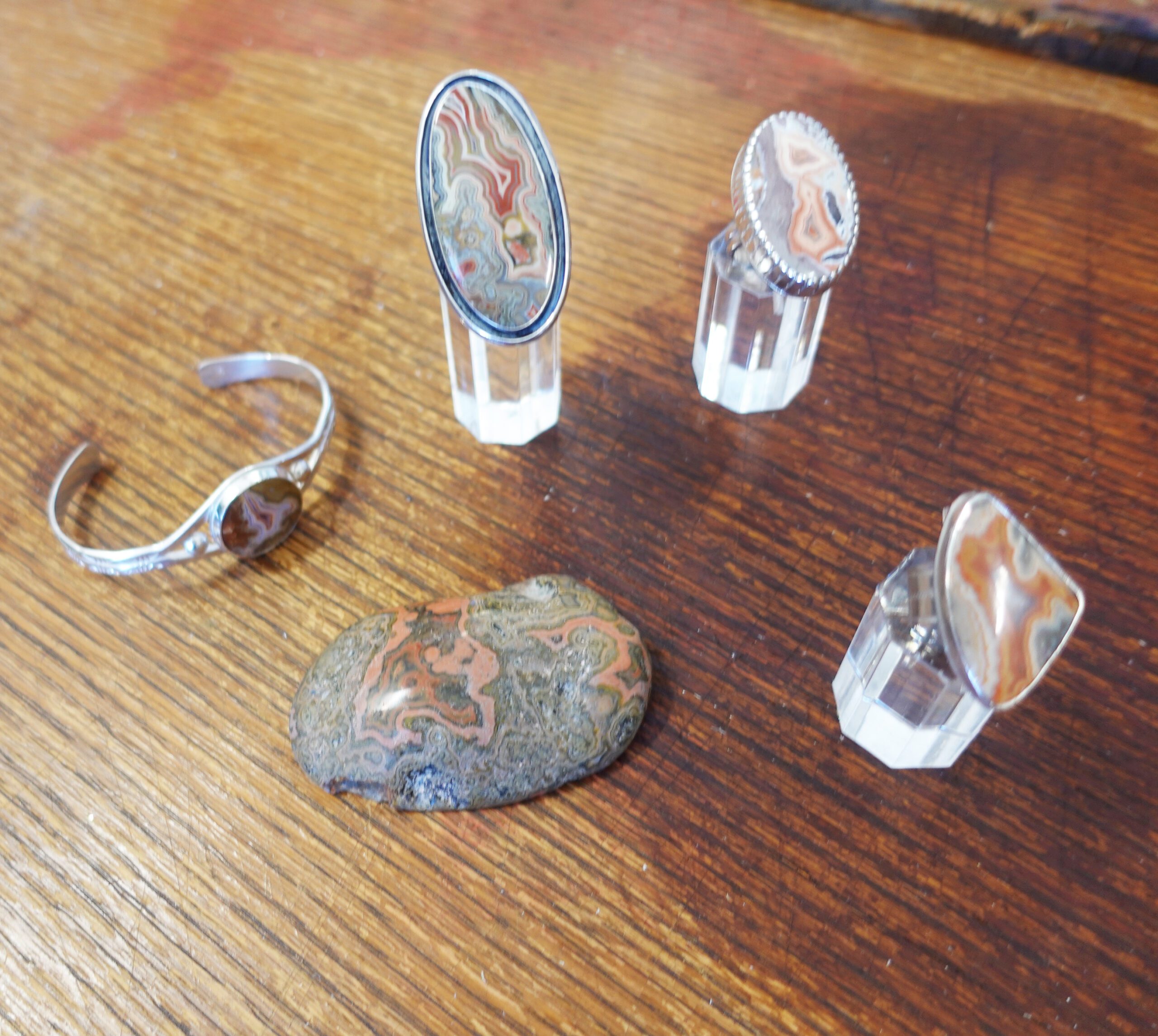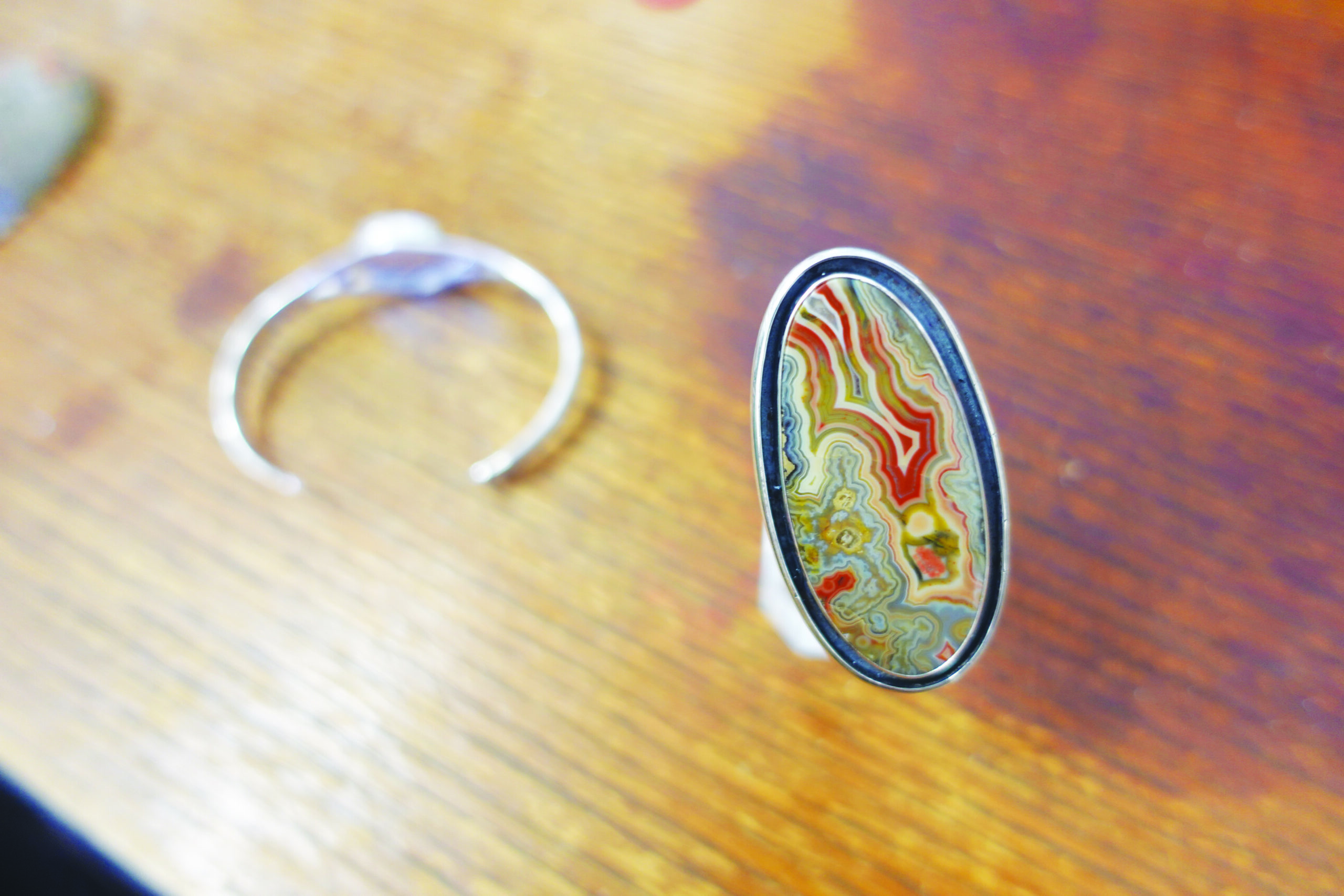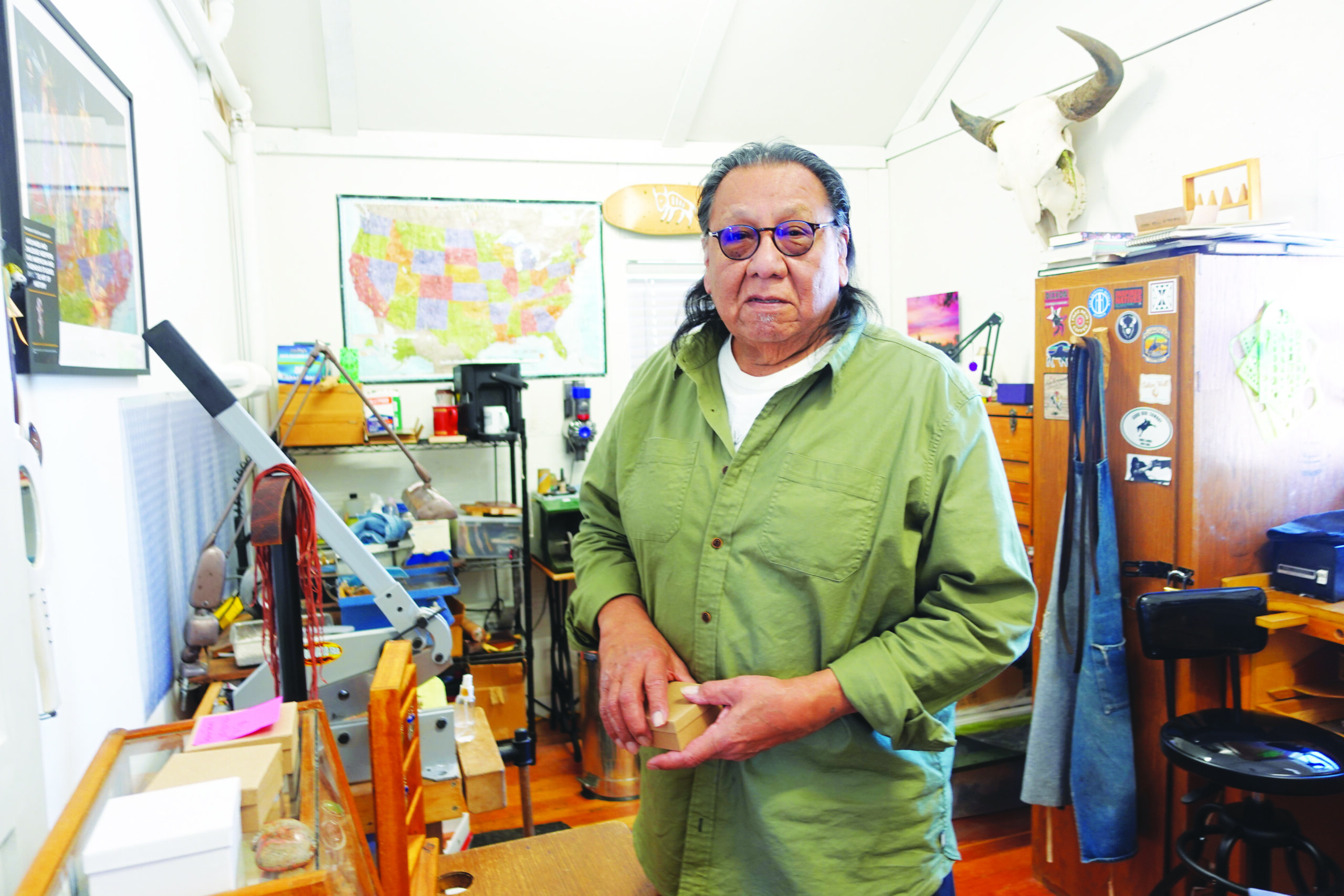Agates: Gifts from Mother Earth
RAPID CITY – It is staggering to think of how time is preserved in an agate. “These are estimated to be 500 million years old,” said Oglala Lakota creative Jhon Goes In Center talking about the agates that he finds and collects. “You can see the motifs of the culture. Some of these agates have patterns in them that I really admire. “
Goes In Center collects and uses the agates in his lapidary work. Lapidary is the art of cutting and polishing stones. It has been in practice for millennia. Humans used stones to make tools and weapons. Eventually these techniques were used to make items of personal adornment.
Goes In Center said he creates adornments using all kinds of different mediums but most recently has narrowed it down to doing lapidary work using agates. “These are gifts from Mother Earth. There’s an energy there, the power of creation is in there.”
There is a recognizable energy as you enter his studio at Racing Magpie. Nearly every surface of his small studio is covered with small, thin slices of agates, fragile and marked by random patterns, many already cut and polished revealing their banded secrets while many others are in various states of cutting and polishing.
South Dakota is one of the few mineral rich areas in the nation, which makes it prone to hiding fossils, gemstones and agates. The agates in the Black Hills are considered very rare and sought after. The most famous is the Fairburn Agate which is named the official state gemstone recognizable by its bright colors and tight banding. The Fairburn is the most popular because it is so elusive and rare. Vigorous hunters flock to the Black Hills in their search. Goes In Center, who finds his agates in the Black Hills and Badlands, says he just waits to them to find him. “What’s unique about them is that they were formed in water, which makes them very rare, so they have a direct connection to our creation story. These agates surfaced during the uplift of the Black Hills,” Goes In Center explained. “They’re embedded in a limestone rock formation known as the Minnelusa Formation which came up with the uplift.”
Goes In Center is referencing specific geologic history. The Minnelusa Formaton is a geologic formation made of layers of limestones, sandstones and shales. The rocks that form the Black Hills are among the oldest, estimated to be 2 billion years or older. South Dakota was once a part of the Western Interior Seaway (WIS). The world was pretty violent at this time – tectonic plates were moving, land was shifting, breaking-up and reforming. Plate abduction caused the mountains on the edges of North America to build and the Gulf of Mexico basin to subside. This allowed seawater to travel north into the western interior. The Black Hills during this time was at the bottom of this vast ocean.
Agates are formed within the cavities of volcanic rocks. Trapped gases within the liquid volcanic material create the cavities which then fill up with the silica rich fluids, depositing layers on the cavity walls. The host rock is often less durable and more subject to erosion. Once eroded, the agate is revealed intact but detached. An agate is characterized by bands of quartz with minor impurities. The “banding” is caused by the alternating deposition of layers of silica with different colors.
Agates are also found in sedimentary rocks like limestone and dolomite. The cavities that are formed in the sedimentary rocks are created from decomposed branches and other buried organic material. The water rich silica slowly trickles through passageways in the rock of the Black Hills, and over time silica accumulates inside tiny pockets, creating an agate.
“There is no other Lakota artist that has developed an affinity to the creation of the Black Hills, using those agates that not only have a geologic connection but a cultural connection.” Goes In Center does metalworking. He does engraving as well, “but there is no other Lakota artist I know that actually does engraving on metal. And does lapidary work of cutting and polishing agates. It doesn’t stand out like all the other art forms like painting, those are kind of like mainstream mediums, but mine is like an adornment so I call my work the art of personal adornment.”
Goes In Center said that all his pieces are unique. “I like to brag to my peers that I don’t really have to go to Hobby Lobby to find my supplies. I like to go out and hunt for agates and collect from other sources and looking at the natural material in my surroundings.”
Goes In Center doesn’t call himself an artist. “After all these years, I’ve been doing this since the early 1970’s, creating things. I started out as a little boy, when I was a child I began to receive articles for dance regalia. Then, as I grew older I would change it myself, update it, bead it, so my creative energy started as a little boy, and dancing. Then that led to seeing relatives around me, seeing what they made. They weren’t artists. They were creatives. So, I mastered all those techniques.”
Goes In Center said he had an interest in antiquities, “So I got a degree in museum studies. I had free reign at the museum at the University of Colorado where I learned a lot of other techniques – I learned preservation work, conservation, exhibiting, documentation, and research.”
He worked at IBM for 17 years. He also worked with mapping technology and eventually started his own consulting company. “I helped First Nations in British Columbia with their treaty process, helping them create their maps.” Goes In Center said their mapping system was much different. He described the importance of that work. “The land was a mosaic of clan systems that had knowledge and subsistence data of all kinds, historical and cultural, the land and the watersheds, all bound together. These maps were regular polygons. You can overlay that information on top of government data and then enable tribes to extrapolate data, for instance, how much timber has been taken out of their aboriginal territory in the last 70 years, and then compilate that as leverage in your treaty process.”
Goes In Center talked about the commercialization of Native art. “In the 1970s you have to remember it was pretty vogue, all this silver and turquoise jewelry being called ‘Indian jewelry.’” He said he made a few pieces of jewelry. Goes In Center was good friends with painter Bobby Penn who had studied under Oscar Howe and became one of the leading Native American painters. “He was probably the greatest painter of modern times. So, I decided I would do something different.”
He said he just kind of fell into doing Plains Indian silverwork. “I was inspired by a Pawnee silversmith, his name was Julius Ceasar. I really liked his work because his stuff was so culturally founded. He used a lot of German silver and created a lot of Peyote style jewelry.” What impressed Goes In Center was how Ceasar’s works was culturally oriented. “He used a lot of German silver and created a lot of Peyote style jewelry. That impressed me, the fact that it was all culturally oriented. It had nothing to do with turquoise. But it was made within the culture for the culture with the culture. And then the fact that he used German silver which is a base metal. It doesn’t have any precious value. It’s an alloy that was developed in the 1840’s. It came as trade annuities.”
Goes In Center said there is a reference from the 1840’s by the Kiowa in one of their Sundances. “We’ re talking about Plains Indians who were doing metal work in the mid-1800’s pre-dating all this phenomena in the Southwest. All my research has pointed toward the creativity of native people. When they get a new material, how they internalize it, and come out with a cultural expression with new materials. And then it’s all based on pleasing our culture. Our adornments were the major expression of our creativity because we were mobile. All of this has been amalgamating, leading me towards today about the adornment arts. So I still create things like this (breast plate), which are still part of our culture. I still do featherwork. I still do custom pieces like buckles.
I don’t make one thing I make many things. I talk with the person who comes to me and we create something together. There’s a creative challenge. But I really do center myself around adornment because that’s one of the truest forms of creativity in the Plains Indian culture. “
Goes In Center still does consulting but his focus is on creating, “The idea of retiring is not in my paradigm. What do I want to be when I grow up? I want to have all my things around me. I want to have the freedom to come in and make things.”
(Contact Marnie Cook at staffwriter@nativesunnews.com)
The post Agates: Gifts from Mother Earth first appeared on Native Sun News Today.
Tags: Top News



